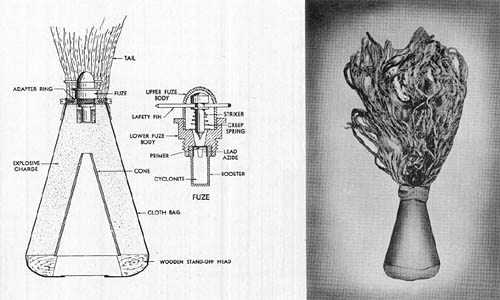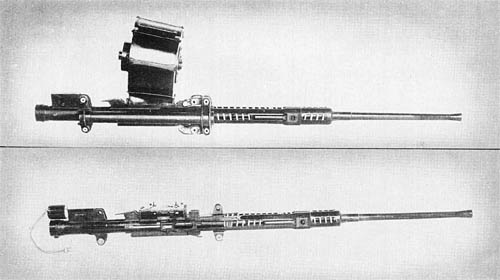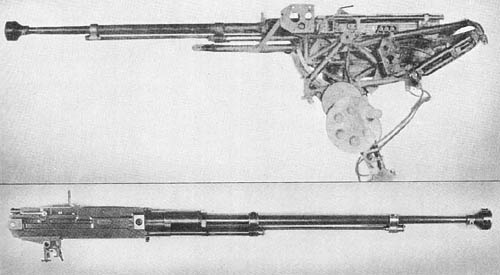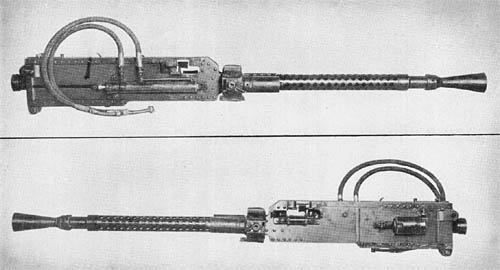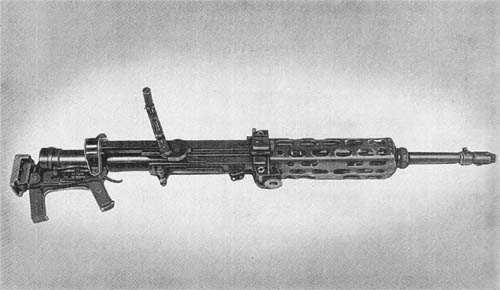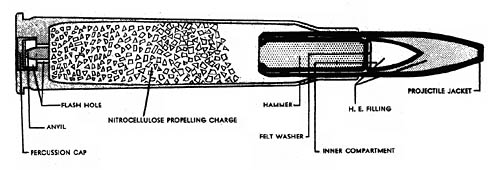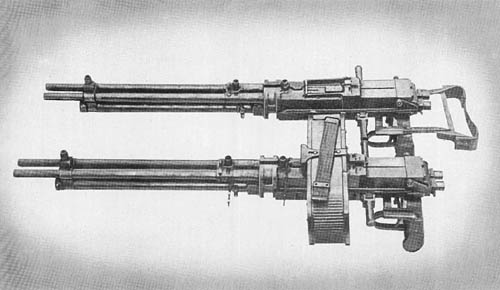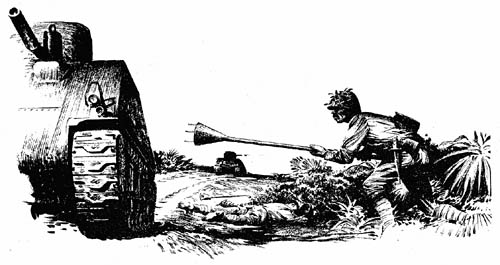
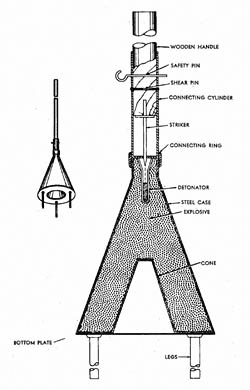 This suicide mine, an antitank device used by Japanese Close-quarter Combat Units, consists of a conical-shaped hollow charge encased in a steel container, and a wooden handle. Three legs equally spaced around the base of the charge provide proper stand-off distance. A well in the apex of the charge contains the detonator.
This suicide mine, an antitank device used by Japanese Close-quarter Combat Units, consists of a conical-shaped hollow charge encased in a steel container, and a wooden handle. Three legs equally spaced around the base of the charge provide proper stand-off distance. A well in the apex of the charge contains the detonator.
The firing mechanism, quite simple in construction, consisting of a needle type striker, a shear pin, and a safety pin, is housed in a metal sleeve. This sleeve, which holds the mine” and the handle 2.4 inches apart, slips over the end of the handle and is held in place by the shear pin and safety pin; it is attached to the body of the mine by a threaded connecting ring.
To operate the mine, the soldier must first remove the safety pin, and then, using bayonet tactics, lunge forward striking the mine squarely against the tank. When the legs of the mine strike the target, the handle is driven forward breaking the shear pin, and the striker is driven into the detonator, initiating explosion of the mine.
Reports indicate that when head-on contact is made, the mine will penetrate 6 inches of steel plate; with contact at a 60° angle, steel plates of approximately 4 inches can be penetrated.
SPECIFICATIONS
| Length of mine body (approx.) | 12 ins. | |
| Diameter of base of body (approx.) | 8 ins. | |
| Length of handle | 59 ins. | |
| Diameter of handle | 1 1/4 ins. | |
| Weight of explosive charge | 6 1/2 lbs. | |
| Length of legs | 5 1/4 ins. | |
| Weight of mine (total) | 14.3 lbs. |
Japanese: p. 308.3 (May 1, 1945)
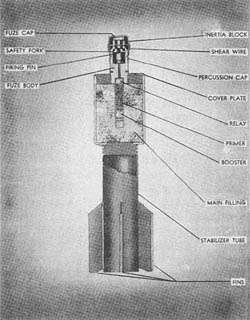 This grenade, designed to be fired from Models 38 and 99 rifles by means of a spigot launcher and wooden bullet, is similar in use and operation to the Model 91 rifle grenade. However, it is smaller and has a smooth-wall body rather than the serrated type. It contains a cyclonite primer enclosed in a brass container, a tetryl booster, and a three-ounce bursting charge of cast TNT; it is also fitted with an instantaneous fuze and a tail assembly with four fins spot welded to the rear part of the tube.
This grenade, designed to be fired from Models 38 and 99 rifles by means of a spigot launcher and wooden bullet, is similar in use and operation to the Model 91 rifle grenade. However, it is smaller and has a smooth-wall body rather than the serrated type. It contains a cyclonite primer enclosed in a brass container, a tetryl booster, and a three-ounce bursting charge of cast TNT; it is also fitted with an instantaneous fuze and a tail assembly with four fins spot welded to the rear part of the tube.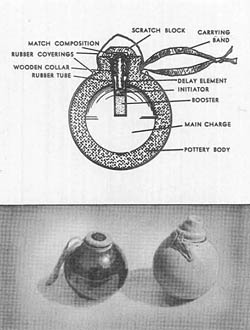 This hand grenade, made of terra cotta, and, like the Model 3 Flower Pot Land Mine, filled with Type 88 explosive, is assumed to be a Navy weapon. Except for the neck at the top, it is spherical, consisting of two halves baked together. It is light brown, in color, and lightly glazed both inside and out. The grenade is encased in a straw-colored, waterproof rubber sack.
This hand grenade, made of terra cotta, and, like the Model 3 Flower Pot Land Mine, filled with Type 88 explosive, is assumed to be a Navy weapon. Except for the neck at the top, it is spherical, consisting of two halves baked together. It is light brown, in color, and lightly glazed both inside and out. The grenade is encased in a straw-colored, waterproof rubber sack.